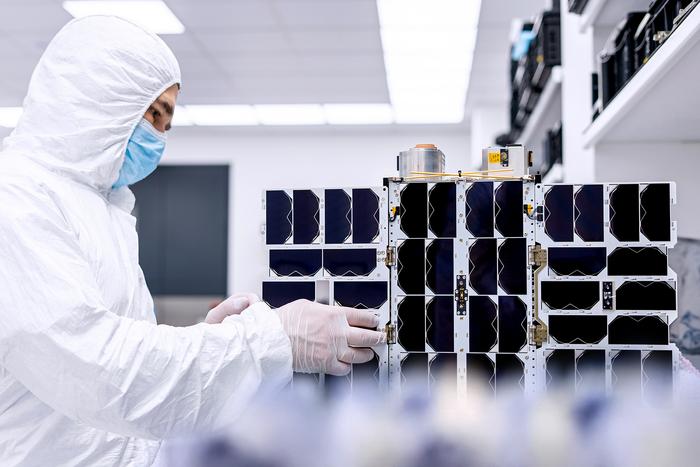Kongsberg NanoAvionics, a trailblazer in the small satellite sector, has forged a partnership with the Institute for Basic Science (IBS) in South Korea to pioneer a groundbreaking initiative aimed at unraveling the secrets of Venus. This audacious project, named CLOVE (Chasing the Long-term Variability of Our Nearest Neighbor Planet Venus), marks a pivotal moment in planetary science. The initiative is centered on deploying a constellation of CubeSats, starting with the first satellite, CLOVESat-1, which is set for launch in 2026. This CubeSat mission is billed as the world’s first long-term observational campaign targeting the enigmatic atmosphere of Venus from low Earth orbit.
The CLOVE initiative has roots in the Planetary Atmospheres Group at IBS, a research endeavor dating back to 2022. The overarching goal is to conduct comprehensive studies of Venus’s atmospheric dynamics and understand its climatic shifts, particularly in the context of solar activity cycles. With plans to launch a new satellite every three years over a span of 15 years, the CLOVE project aims to gather longitudinal data on Venus’s atmospheric phenomena, thereby enabling scientists to investigate changes across a full solar cycle.
Under the terms of the contract, Kongsberg NanoAvionics will take responsibility for the complete assembly of the CubeSat, integrate the scientific payload—crafted through collaborative efforts within South Korea—and facilitate environmental testing to ensure mission readiness. The company will also arrange the satellite’s launch services and manage crucial launch and early orbit operations (LEOP), marking an essential phase in any space mission.
CLOVESat-1 will serve as a formidable observational platform for studying the vertical structure of clouds, alterations in cloud top altitudes, and the abundance of gaseous sulfur dioxide in Venus’s atmosphere. The satellite’s scientific instruments will be capable of detecting a range of wavelengths, from ultraviolet to near-infrared, with multiple channels designed specifically to gather data in conjunction with terrestrial observatories.
LEE Yeon Joo, the Chief Investigator at IBS, emphasized the project’s significance for South Korea’s ascent in planetary science. He noted that the mission is not merely an academic endeavor but a leap into the future of space exploration through advanced instrumentation. The collaborative effort with NanoAvionics is seen as pivotal in facilitating continuous data acquisition that previous missions have not achieved. These data will be invaluable for enhancing our understanding of Venus’s atmospheric evolution, climate dynamics, and its broader implications for Earth-like planets.
Atle WØLLO, CEO of Kongsberg NanoAvionics, heralded the mission as a reflection of the increasing role small satellites play in modern astrophysics. He pointed to various successful missions where their small satellites have filled observational gaps and provided essential data alongside larger missions. With a portfolio boasting over 20 research missions, which encompass realms from material science to Earth observation, CLOVESat-1 represents an expansion into the relative unknown of planetary research.
The high temporal resolution data captured by CLOVESat-1 is anticipated to elucidate nuanced atmospheric phenomena and deliver insights into Venus’s climatic transitions over the designated 15-year observational window. This long-term data collection is expected to unveil vital information regarding volcanic activity, interactions within the solar atmosphere, and overarching planetary climate transformations. Such knowledge is crucial for deciphering how a planet that once exhibited Earth-like properties evolved into its present inhospitable state.
Complementing this initiative will be the synchronized observation efforts from subsequent CLOVESat missions, which will coincide with NASA and ESA’s upcoming Venus missions including DAVINCI, VERITAS, and EnVision. The collaborative data from these missions is expected to serve as a comparative framework, enhancing the resolution and accuracy of observations while the advanced orbiters collect high spatial resolution data.
As the journey to unravel the mysteries of Venus commences, the excitement surrounding the CLOVESat project encapsulates a significant leap in the domain of planetary science. The insights garnered through this comprehensive observational campaign promise to reshape our understanding of Venus, a planet long seen as a paradox within our solar system. As data becomes available to the global scientific community, the hope remains that this influx of knowledge will catalyze further exploration and interdisciplinary studies related to planetary atmospheres.
In summary, the CLOVE project represents a fusion of innovation, collaboration, and ambition, encapsulating the spirit of modern space exploration. It underscores the importance of small satellites in expanding the frontiers of scientific knowledge and invites participation from researchers worldwide, signaling a future where data sharing and collective inquiry about planetary atmospheres become paramount.
Subject of Research: Monitoring Venus’s Atmospheric Changes through CubeSat Technology
Article Title: Kongsberg NanoAvionics and IBS Launch Groundbreaking Venus CubeSat Initiative
News Publication Date: 2 June 2025
Web References:
References:
Image Credits: Kongsberg NanoAvionics
Keywords
CubeSat, Venus, Planetary Science, Kongsberg NanoAvionics, IBS, Atmosphere Monitoring, CLOVE Project, Earth-like Planets, Remote Sensing, Climate Change, Space Exploration, Long-term Observation.




